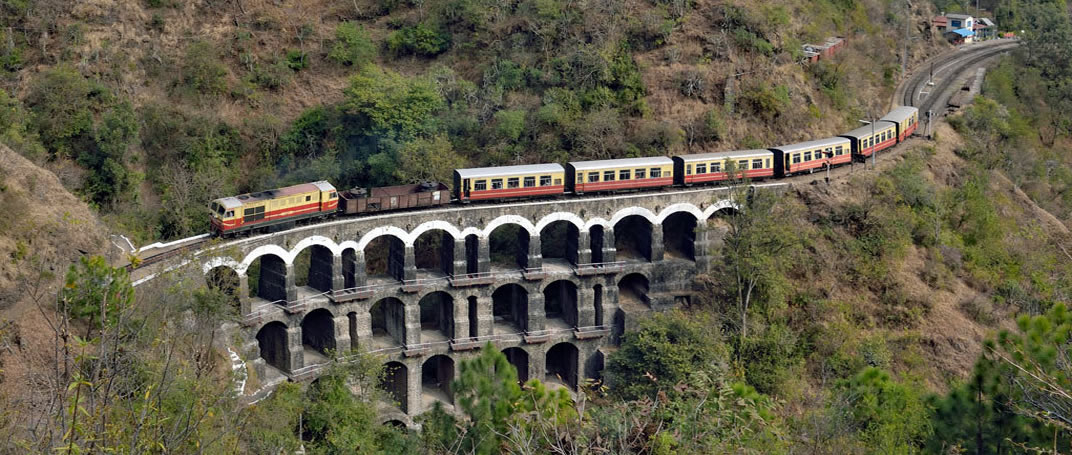India, a land of diverse cultures and rich history, boasts a remarkable network of heritage trains that not only serve as a mode of transportation but also stand as a testament to its glorious past. Among these, the Shimla-Kalka train route and others like the Palace on Wheels, Darjeeling Himalayan Railway, Nilgiri Mountain Railway, and many more play a significant role in preserving India's heritage and uplifting the local communities they traverse through. In this article, we delve into the profound impact of Indian heritage trains, including these iconic routes, on the communities they touch upon.
Preservation of Heritage:
Indian heritage trains, such as those traversing the Shimla-Kalka route and others across the country, are more than just means of conveyance; they are living relics of India's past glory. These trains are meticulously maintained to retain their vintage charm, offering passengers a glimpse into a bygone era. By preserving these trains, India conserves its architectural, cultural, and engineering heritage, ensuring that future generations can appreciate and learn from them.
Economic Boost:
The presence of heritage trains, including those along the Shimla-Kalka route and others, injects a significant economic boost into the local communities along their paths. From tourism revenue to employment opportunities, these trains serve as catalysts for economic development. Local artisans, craftsmen, and vendors often benefit from the influx of tourists who flock to experience the nostalgia and beauty offered by these trains. Additionally, heritage train stations become hubs of activity, leading to the growth of small businesses and hospitality services in the vicinity.
Cultural Exchange and Promotion:
Heritage trains, including those traversing the Shimla-Kalka route and others, serve as ambassadors of Indian culture, both domestically and internationally. They provide a platform for cultural exchange as passengers from diverse backgrounds come together to embark on a journey through history. Tourists not only get to experience the sights and sounds of India but also interact with locals, fostering mutual understanding and appreciation. Moreover, these trains contribute to promoting India's rich cultural heritage on the global stage, attracting tourists from around the world and enhancing the country's soft power.
Sustainable Tourism:
In recent years, there has been a growing emphasis on sustainable tourism practices, and heritage trains, including those on the Shimla-Kalka route and others, exemplify this ethos. Unlike modern modes of transportation that rely heavily on fossil fuels, many heritage trains operate using eco-friendly methods such as steam or diesel-electric hybrids. Furthermore, these trains often follow scenic routes, encouraging passengers to appreciate the natural beauty of the landscapes they traverse. By promoting sustainable tourism, heritage trains contribute to environmental conservation efforts while offering travelers a unique and immersive experience.
Empowerment of Local Communities:
Perhaps the most significant impact of Indian heritage trains, including those along the Shimla-Kalka route and others, is the empowerment of local communities along their paths. These trains create employment opportunities for a wide range of individuals, including train staff, tour guides, and hospitality workers. Additionally, heritage train projects often involve local communities in their operation and maintenance, providing them with a sense of ownership and pride. Moreover, the influx of tourists brings attention to lesser-known regions, thereby stimulating infrastructural development and improving living standards in these areas.
Challenges and Opportunities:
While Indian heritage trains, including those along the Shimla-Kalka route and others, offer numerous benefits, they also face challenges that need to be addressed. Preservation efforts require substantial financial resources, and ensuring the safety and integrity of aging infrastructure is a constant concern. Moreover, striking a balance between tourism promotion and environmental conservation is essential to sustainably manage heritage train operations. However, with proper planning and investment, these challenges can be overcome, and heritage trains can continue to play a vital role in India's cultural and economic landscape.
Conclusion:
Indian heritage trains, including those along iconic routes like Shimla-Kalka and others across the country, stand as living monuments to the country's rich history and cultural heritage. Beyond their nostalgic allure, these trains have a profound impact on the communities they touch upon. From preserving architectural marvels to empowering local economies, heritage trains contribute to India's socio-economic development in myriad ways. As custodians of this invaluable heritage, it is imperative to ensure that these trains continue to thrive, enriching the lives of both passengers and communities for generations to come.
For More Articles Click





Comments